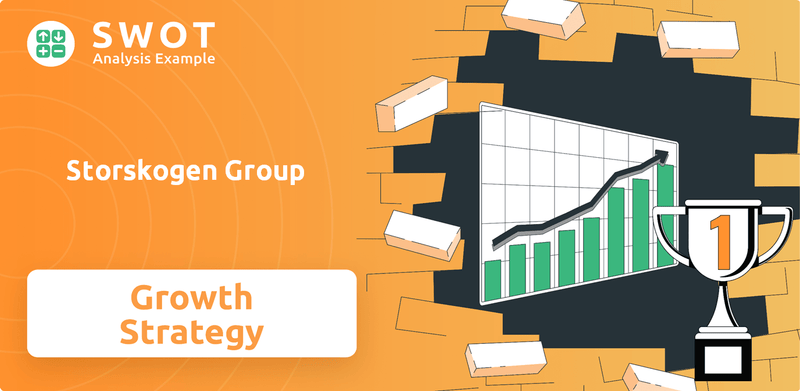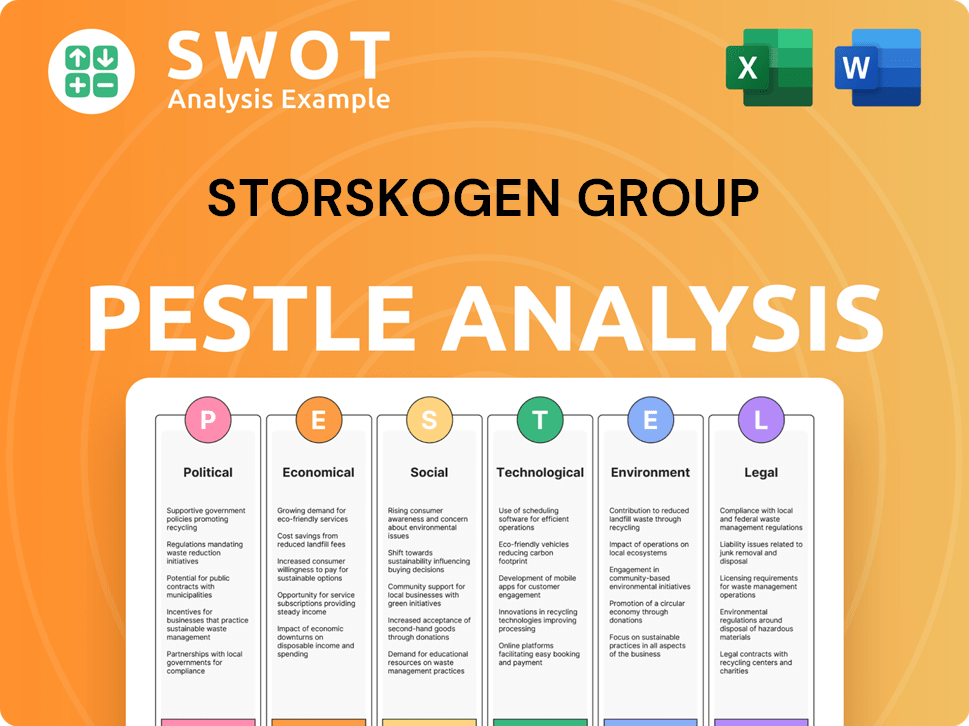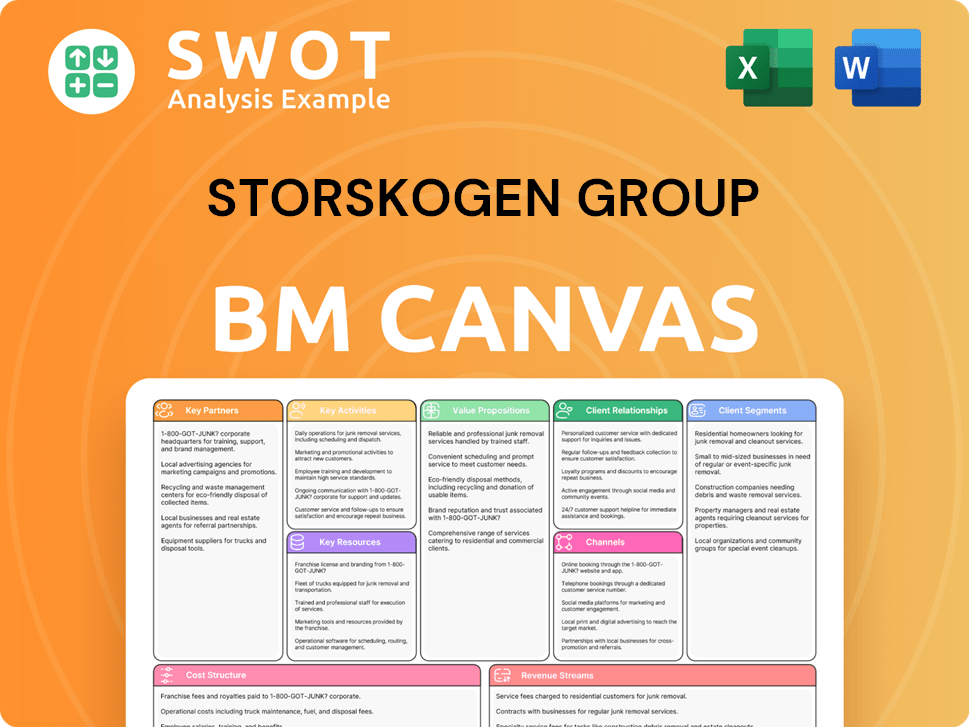Storskogen Group Bundle
Can Storskogen Group Continue Its Impressive Growth Trajectory?
Founded in Sweden in 2012, Storskogen Group has quickly become a major player in acquiring and operating profitable small and medium-sized enterprises (SMEs) internationally. Their unique approach focuses on empowering these businesses through a decentralized model, fostering entrepreneurial spirit while providing crucial support. This strategy has enabled Storskogen to become a key player in the SME market, offering a pathway for growth and new ownership.

With a portfolio spanning 129 business units across 30 countries, Storskogen Group's Storskogen Group SWOT Analysis provides a comprehensive look at its strengths, weaknesses, opportunities, and threats. This article will explore the company's Growth Strategy and Future Prospects, examining how it plans to leverage its diversified Investment Portfolio and drive Business Development in an ever-changing global landscape. We will delve into the company's expansion plans and analyze its long-term strategic goals, providing valuable insights for investors and business strategists alike.
How Is Storskogen Group Expanding Its Reach?
The Storskogen Group's growth strategy centers on both organic expansion and strategic acquisitions. This approach is supported by a decentralized operational model, which allows acquired businesses to maintain their entrepreneurial independence while benefiting from the resources and expertise of the larger group. The company focuses on acquiring profitable companies with established business models within select industries, identifying an 'evergreen opportunity' in the market for small and medium-sized enterprises (SMEs).
This strategy is designed to fuel business development and enhance its investment portfolio. The company's focus on acquiring and integrating businesses strategically positions it for sustained growth and market leadership. The emphasis on profitable companies with proven models ensures a solid foundation for expansion and value creation.
The company actively pursues acquisitions to diversify its revenue streams and expand its market presence. This dual approach allows Storskogen Group to access new customers, diversify revenue streams, and stay ahead of industry changes. The company's strategic goals include geographic diversification and expanding its presence in key European markets.
The company employs a dual approach to acquisitions, including platform acquisitions, which establish standalone business units, and add-on acquisitions, which integrate companies into existing units. This strategy facilitates access to new customers, diversifies revenue streams, and allows the company to adapt to industry changes. This dual approach supports the company's expansion into new markets and strengthens its position within existing ones.
The company is actively expanding its geographical footprint, focusing on markets such as Germany, Switzerland, and Norway. This expansion strategy is designed to diversify its revenue streams and reduce its reliance on any single market. The company's expansion plans in Europe are a key component of its long-term strategic goals.
In 2023, Storskogen Group completed twelve acquisitions, which collectively generated SEK 690 million in annual sales. During the same period, the company also completed eleven divestments, with combined annual sales of SEK 1,875 million. These transactions are a crucial part of the company's strategy to optimize its portfolio and drive growth.
More recently, in 2024, the company completed five add-on acquisitions with combined annual sales of SEK 23 million. Additionally, eleven divestments were completed, with combined annual sales of SEK 2,024 million. A significant divestment in 2024 involved the sale of nine business units to M Industrial Invest Ab, with combined annual sales of approximately SEK 1,583 million as of March 31, 2024.
The company's expansion strategy is multifaceted, involving both organic growth within existing business units and strategic acquisitions. The decentralized operational model supports these initiatives by allowing acquired businesses to maintain their independence while benefiting from the resources of the larger group. The company is focused on acquiring profitable companies with proven business models.
- Platform Acquisitions: Creating standalone business units.
- Add-on Acquisitions: Integrating companies into existing units.
- Geographic Diversification: Expanding into new markets like Germany, Switzerland, and Norway.
- Focus on SMEs: Targeting profitable companies with proven business models.
Storskogen Group SWOT Analysis
- Complete SWOT Breakdown
- Fully Customizable
- Editable in Excel & Word
- Professional Formatting
- Investor-Ready Format

How Does Storskogen Group Invest in Innovation?
The Owners & Shareholders of Storskogen Group approach to sustained growth heavily relies on technology and innovation. This is especially true in supporting its decentralized business units. These units often face challenges in areas like digitalization and internationalization, which the central organization helps address.
This support is crucial for the company's Growth Strategy. By providing resources and expertise, the central organization enables its diverse portfolio of businesses to adapt and thrive in a rapidly evolving market. This approach is designed to enhance the Future Prospects of the group.
Storskogen is actively working on solutions to cut emissions. This includes electrifying fleets and using alternative fuels. They are focusing on companies with high carbon footprints. The company anticipates investments in areas like electric vehicles, renewable energy, and energy-efficient systems. This is part of their plan to reach Net Zero by 2050.
The central organization provides support to its decentralized business units, particularly in digitalization. This helps smaller companies navigate the complexities of digital transformation.
Storskogen is committed to reducing emissions. This includes investments in electric vehicles and renewable energy. The goal is to achieve Net Zero emissions by 2050.
Storskogen is preparing to comply with the EU's Corporate Sustainability Reporting Directive (CSRD). A sustainability committee has been established to oversee and monitor these initiatives.
The focus on sustainable technology and energy-efficient computing is a competitive advantage. It aligns with environmental goals and enhances market positioning.
The decentralized business model allows for strategic and operational support from the central organization. This support includes sustainability initiatives and corporate governance.
Storskogen plans climate-related investments in areas like electrified vehicles, renewable energy, and energy-efficient systems. These investments are crucial for achieving their sustainability goals.
Storskogen's approach to innovation and technology is multifaceted, focusing on both internal support and external investments to drive growth and sustainability. This approach is crucial for the Company Analysis and its Investment Portfolio.
- Supporting digitalization across its business units to enhance efficiency and competitiveness.
- Investing in climate-related technologies, such as electric vehicles and renewable energy, to reduce emissions and achieve Net Zero targets.
- Preparing for compliance with the EU's CSRD to ensure transparent sustainability reporting.
- Leveraging sustainable technology and energy-efficient computing to gain a competitive edge.
Storskogen Group PESTLE Analysis
- Covers All 6 PESTLE Categories
- No Research Needed – Save Hours of Work
- Built by Experts, Trusted by Consultants
- Instant Download, Ready to Use
- 100% Editable, Fully Customizable

What Is Storskogen Group’s Growth Forecast?
The financial outlook for Storskogen Group reflects a strategic focus on profitability and cash flow, crucial elements for its future growth. The company's performance in recent periods showcases its ability to navigate market dynamics while maintaining a strong financial position. Understanding the financial trajectory is key to assessing the Growth Strategy and Future Prospects of Storskogen Group.
Storskogen Group's financial results for 2024 and Q1 2025 provide insights into its operational efficiency and strategic decisions. These figures are essential for investors and stakeholders to evaluate the company's performance and potential for future growth. A detailed Company Analysis is necessary to understand the implications of these financial outcomes.
The company's strategic moves, including acquisitions and divestments, significantly influence its financial results. These actions are part of the broader Business Development strategy aimed at enhancing its Investment Portfolio. Analyzing these financial figures helps in understanding the impact of these strategies on the company's overall performance and future outlook.
For the full year 2024, Storskogen reported a decrease in net sales to SEK 34,182 million, a 5 percent drop compared to SEK 36,006 million in 2023. Organic sales growth remained at 0 percent. Adjusted EBITA was SEK 3,229 million, with an adjusted EBITA margin of 9.4 percent.
In Q1 2025, Storskogen's net sales were SEK 7,940 million, a 5 percent decrease from SEK 8,358 million in Q1 2024, mainly due to divestments. Adjusted EBITA for Q1 2025 was SEK 700 million, with an adjusted EBITA margin of 8.8 percent. Profit increased by 50 percent to SEK 216 million.
At its Capital Markets Day in November 2024, Storskogen outlined new financial targets. These include an adjusted EBITA growth CAGR of 15 percent, an adjusted EBITA margin above 10 percent, and an adjusted cash conversion above 70 percent. The company also aims for a leverage ratio of 2.0-3.0x.
The dividend policy is set at 0-20 percent of Group net profit. The Board proposed a dividend of SEK 0.10 per share for 2024, payable on May 14, 2025. Storskogen successfully refinanced its term loan facility in Q1 2025, increasing it to EUR 345 million and extending its maturity to September 2027.
Storskogen's financial performance is driven by strategic decisions aimed at sustainable growth. The company's focus on profitability, cash flow, and disciplined capital allocation are key to achieving its long-term objectives. For more insights, you can read about the Mission, Vision & Core Values of Storskogen Group.
- Adjusted EBITA Growth: Aims for a 15 percent CAGR from 2025-2027.
- EBITA Margin: Targets an adjusted EBITA margin above 10 percent.
- Cash Conversion: Aims for an adjusted cash conversion above 70 percent.
- Leverage Ratio: Targets a leverage ratio of 2.0-3.0x.
Storskogen Group Business Model Canvas
- Complete 9-Block Business Model Canvas
- Effortlessly Communicate Your Business Strategy
- Investor-Ready BMC Format
- 100% Editable and Customizable
- Clear and Structured Layout

What Risks Could Slow Storskogen Group’s Growth?
The Storskogen Group, like any large, diversified entity, faces a spectrum of potential risks and obstacles that could influence its Growth Strategy and Future Prospects. These challenges span financial, operational, and emerging risk categories. Understanding these risks is crucial for a thorough Company Analysis and evaluating the firm's long-term viability.
Financial risks, including capital access, interest rate fluctuations, and currency exchange rates, are actively managed through a finance policy and data-driven forecasting. Operational risks, such as those related to internal processes and data security, are mitigated through robust governance and adherence to group-wide principles. Furthermore, emerging risks like geopolitical instability and climate change introduce additional complexities that the group must navigate.
The company's ability to adapt to these risks will significantly shape its Business Development and overall success. Addressing these challenges requires proactive strategies and continuous monitoring to ensure sustainable growth and maintain investor confidence. For a deeper dive into the financial aspects, consider exploring Revenue Streams & Business Model of Storskogen Group.
Storskogen Group manages financial risks through a finance policy. This includes data-driven forecasting of capital needs. The company also diversifies its debt portfolio to reduce refinancing risk, which is a critical aspect of their financial strategy.
The company monitors costs monthly. They implement measures such as price increases or cost savings through framework agreements. These actions are designed to mitigate the risks associated with inflation and maintain profitability.
Impairment risk, particularly for goodwill and other assets, is addressed through quarterly simplified impairment testing. This is followed by annual full impairment testing to ensure the accurate valuation of assets. This proactive approach helps maintain the financial health of the Investment Portfolio.
Operational risks encompass challenges related to effectiveness, internal processes, resource utilization, systems, and employees. Data and information security are also key operational risks. The decentralized model requires robust governance to ensure subsidiaries adhere to group-wide principles and a code of conduct.
Emerging risks include broader geopolitical instability, rising protectionism, and weakening trust. Misinformation, societal polarization, and the adverse outcomes of AI technologies are also growing concerns, as highlighted in the World Economic Forum's Global Risks Report 2025. These risks could significantly impact Future Growth Opportunities for Storskogen Group.
Climate-related risks include new regulations, carbon pricing, and shifting customer preferences. These factors could increase operational costs and impact supply chains. Storskogen Group integrates climate-related risks and opportunities into its risk management and strategic planning, aligning with Storskogen Group's sustainability initiatives.
The Storskogen Group relies on access to capital for its Growth Strategy, including acquisitions. Fluctuations in interest rates and the overall cost of borrowing can affect the company's financial performance. Managing capital effectively is critical for Storskogen Group's investment in small and medium-sized businesses.
The decentralized structure, while fostering entrepreneurship, requires strong governance to ensure consistency across all subsidiaries. This includes adherence to group-wide principles and a code of conduct. Effective governance is essential for managing Storskogen Group's expansion plans in Europe and maintaining operational efficiency.
Global economic and geopolitical events can significantly impact the company's operations. Rising protectionism, trade barriers, and economic downturns pose challenges. The company must monitor these factors closely to adapt its strategies and protect its market share analysis.
Climate change regulations and shifting consumer preferences towards sustainable products present both risks and opportunities. Storskogen Group is integrating climate-related considerations into its risk management and strategic planning. This proactive approach is vital for achieving Storskogen Group's long-term strategic goals.
Storskogen Group Porter's Five Forces Analysis
- Covers All 5 Competitive Forces in Detail
- Structured for Consultants, Students, and Founders
- 100% Editable in Microsoft Word & Excel
- Instant Digital Download – Use Immediately
- Compatible with Mac & PC – Fully Unlocked

Related Blogs
- What are Mission Vision & Core Values of Storskogen Group Company?
- What is Competitive Landscape of Storskogen Group Company?
- How Does Storskogen Group Company Work?
- What is Sales and Marketing Strategy of Storskogen Group Company?
- What is Brief History of Storskogen Group Company?
- Who Owns Storskogen Group Company?
- What is Customer Demographics and Target Market of Storskogen Group Company?
Disclaimer
All information, articles, and product details provided on this website are for general informational and educational purposes only. We do not claim any ownership over, nor do we intend to infringe upon, any trademarks, copyrights, logos, brand names, or other intellectual property mentioned or depicted on this site. Such intellectual property remains the property of its respective owners, and any references here are made solely for identification or informational purposes, without implying any affiliation, endorsement, or partnership.
We make no representations or warranties, express or implied, regarding the accuracy, completeness, or suitability of any content or products presented. Nothing on this website should be construed as legal, tax, investment, financial, medical, or other professional advice. In addition, no part of this site—including articles or product references—constitutes a solicitation, recommendation, endorsement, advertisement, or offer to buy or sell any securities, franchises, or other financial instruments, particularly in jurisdictions where such activity would be unlawful.
All content is of a general nature and may not address the specific circumstances of any individual or entity. It is not a substitute for professional advice or services. Any actions you take based on the information provided here are strictly at your own risk. You accept full responsibility for any decisions or outcomes arising from your use of this website and agree to release us from any liability in connection with your use of, or reliance upon, the content or products found herein.